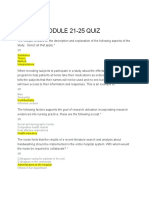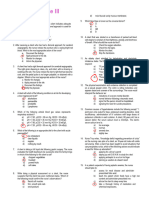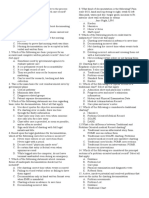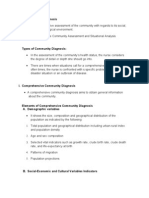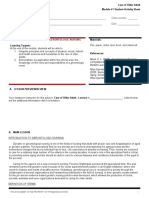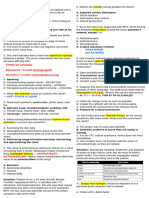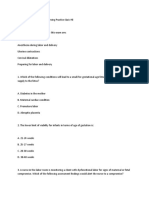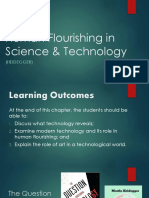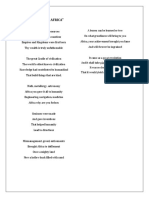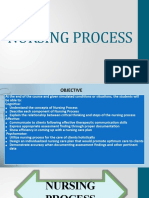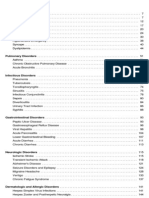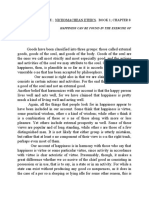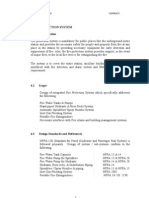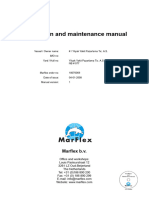Pharma Notes
Uploaded by
Rishiel Dimple BalonesPharma Notes
Uploaded by
Rishiel Dimple BalonesMODULE 1 • Intraarticular- within a joint
DRUG DEFINITIONS & CLASSIFICATIONS • Intrathecal- within a sheath
DEFINITION OF PHARMACOLOGY • Medication Error- Any preventable adverse drug event
involving inappropriate medication use.
• The word pharmacology is derived from Greek words:
o Pharmakon – “drug/medicine” in modern Greek, • Medication use process- The prescribing, dispensing, and
“poison” in classic Greek, and administering of medications, and the monitoring of their
o Logos – “study”, or “the knowledge gained through effects.
study.” • Metabolite- A chemical form of a drug that is the product of
• It is defined as the study of the biological effects of one or more biochemical (metabolic) reactions involving a
chemicals. The chemicals that are introduced into the body parent drug.
to cause some sort of change are called drugs. o Active metabolites: those that have pharmacologic
activity of their own, even if the parent drug is inactive
• Nurses deal with pharmacotherapeutics, or clinical
(see prodrug).
pharmacology, the branch of pharmacology that uses drugs
o Inactive metabolites: lack pharmacologic activity and
to treat, prevent, and diagnose disease. Clinical
are simply drug waste products awaiting excretion from
pharmacology addresses two key concerns:
the body (e.g., via the urinary, GI, or respiratory tract).
o The drug’s effects on the body
o The body’s response to the drug. • Onset of action- The time required for a drug to elicit a
therapeutic response after dosing.
KEY TERMS • Parent drug- The chemical form of a drug that is
administered before it is metabolized by the body into its
• Additive Effect- the effect of a combination of two or more active or inactive metabolites.
drugs o Prodrug: a parent drug that is not pharmacologically
• Adverse Drug Events- undesirable occurrences related to active itself and is then metabolized to a
administering medication. pharmacologically active metabolite.
• Adverse Effects- undesirable effects • Peak effect- The time required for a drug to reach its
• Agonist- A drug that binds to and stimulates the activity of maximum therapeutic response in the body.
one or more receptors in the body. • Peak level- The maximum concentration of a drug in the
• Allergic Reaction- an immunologic hypersensitivity body after administration.
reaction, a type of adverse drug event. • Prodrug- An inactive drug dosage form that is converted to
• Antagonist- A drug that binds to and inhibits the activity of an active metabolite by various biochemical reactions once
one or more receptors in the body. It is also called an it is inside the body.
inhibitor. • Receptor - bind specific substances (e.g., drug molecules),
• Antagonistic Effect- effect of a combination of two or more and one or more corresponding cellular effects (drug
drugs is less than the sum of the individual effects of the actions) occur as a result of this drug-receptor interaction.
same drugs given alone (1 + 1 = <2) • Steady state- The physiologic state in which the amount of
• Bioavailability- A measure of the extent of drug absorption drug removed via elimination is equal to the amount of drug
for a given drug and route (from 0% to 100%). absorbed with each dose.
• Blood-brain barrier- The barrier system that restricts the • Synergistic effects- Drug interactions in which the effect
passage of various chemicals and microscopic entities (e.g. of a combination of two or more drugs with similar actions
bacteria, viruses) between the bloodstream and the central is greater than the sum of the individual effects of the same
nervous system drugs given alone (1 + 1 = >2).
• Contraindication- renders a particular form of treatment • Therapeutic drug monitoring- the process of measuring
improper or undesirable. drug levels to identify a patient’s drug response
• Cytochrome P-450- a large class of enzymes that play a • Therapeutic Effect- The desired or intended effect of a
significant role in drug metabolism and drug interactions. particular medication.
• Dependence- A state in which a compulsive or chronic • Therapeutic index- The ratio between the toxic and
need exists. therapeutic concentrations of a drug.
• Drug actions- The processes involved in the interaction • Tolerance- Reduced response to a drug after prolonged
between a drug and body cells. Also called a mechanism use.
of action. • Toxic- The quality of being poisonous
• Drug classification- A method of grouping drugs • Toxicity- The condition of producing adverse bodily effects
• Drug effects- The physiologic reactions of the body to a due to poisonous qualities.
drug • Toxicology- The study of poisons
• Drug-induced teratogenesis- The development of • Trough level- The lowest concentration of drug reached in
congenital anomalies or defects in the developing fetus the body
caused by the toxic effects of drugs.
• Drug interaction- Alteration in the pharmacologic or CLASSIFICATION OF DRUGS
pharmacokinetic activity of a given drug caused by the
• Therapeutic Classification
presence of one or more additional drugs.
o Drugs are organized based on their therapeutic
• Duration of action- The length of time the concentration of
usefulness in treating particular diseases.
a drug in the blood or tissues is sufficient to elicit a
o The key is to clearly state what a particular drug does
response.
clinically.
• First-pass effect- The initial metabolism in the liver of a
• Pharmacologic Classification
drug absorbed from the GI tract.
o Refers to the way drug works in a the molecular, tissue,
• Half-life- the time required for half of an administered dose and body system levels.
of drug o Addresses a drug’s mechanism of action, or how a
• Idiosyncratic Reaction- an abnormal and unexpected drug produces its physiological effect in the body.
response to a medication
• Intraarterial- within an artery
PHARMACOLOGY (TRANSCRIBED BY: TITO V. BAUTISTA JR.) 1
DRUG NAMES PRESCRIPTION AND NON-PRESCRIPTION DRUGS
• Chemical Name • To obtain a prescription for the drug from a licensed
o Assigned using standard nomenclature provider such as a physician, dentist or nurse practitioner.
o Difficult to remember and pronounce • To purchase drugs that do not require a prescription on an
• Generic Name over-the-counter (OTC) basis.
o Less complicated and easier to remember.
• Trade Name GENERIC DRUGS
o Assigned by a company marketing drug. • Are chemicals that are produced by companies involved
o Sometimes called propriety or product or brand name. solely in the manufacturing of drugs.
• Production of generic drugs are cheaper.
MODULE 2 • Many require that a drug be dispensed in the generic form
DRUG STANDARD & DRUG INFORMATION if one is available.
PHASES OF DRUG EVALUATION
• Preclinical: Laboratory Studies OVER-THE-COUNTER DRUGS
o Provide information on dosing and toxicity levels • Are products that are available without prescription for self-
• Phase 1: Safety treatment of a variety of complaints.
o Evaluate safety
o Gather information about how a drug interacts with the CONTROLLED SUBSTANCES
human body
• The Controlled Substance Act requires scheduling of every
• Phase 2: Safety and Dosing
drug.
o Further evaluate the safety
o This regulates the manufacturing and distribution of
o Monitor side effects
substances with a potential for abuse—examples
o Check which dose works best
include narcotics, hallucinogens, stimulants,
o Check effectiveness
depressants, and anabolic steroids.
• Phase 3: Safety and Efficacy
• These drugs are categorized by schedule, based on their
o Confirm effectiveness
therapeutic use and potential for abuse.
o Monitor safety
• Phase 4: Post-Marketing Safety and Efficiency.
o Gather information on the drug’s effect in various
population and any side effects associated with long-
term use.
DRUG LEGISLATION AND STANDARDS
• The FDA regulates the development and sale of drugs.
• If a pattern of severe reactions to a newly marketed drug
begins to emerge, the FDA may request that the
manufacturer of the drug issue a black box warning or a
voluntary recall.
o It is the strictest warning from the FDA and indicates
that serious adverse effects have been reported with
the drug.
o The drug can still be prescribed—the prescriber must
be aware of the potential risk and the patient must be
warned.
o Are included in the prescribing information of the drug.
• The FDA has a voluntary program called MedWatch in
which professionals are encouraged to report any adverse
events seen with newly approved drugs.
• As part of the standards for testing and safety, the FDA
requires that each new drug be assigned to a pregnancy
category.
• The categories indicate a drug’s potential or actual
teratogenic effects, thus offering guidelines for use of that • The Drug Enforcement Agency (DEA) enforces the law
particular drug in pregnancy. and requires all individuals and companies that handle
controlled substances to provide storage security, keep
accurate records, and include the provider number
assigned by the DEA on all prescriptions for controlled
substances.
ORPHAN DRUGS
• Are drugs that have been discovered but are not financially
viable and therefore have not been “adopted” by any drug
company.
• Abandoned after preclinical trials or phase I studies.
• May be useful in treating a rare disease, or may have
potentially dangerous adverse effects.
PHARMACOLOGY (TRANSCRIBED BY: TITO V. BAUTISTA JR.) 2
CULTURAL AND ETHICAL CONSIDERATIONS IN reduces the bioavailability of the drug to less than
PHARMACOLOGY 100%.
o Distribution- The process of drug movement, or “out
• Ethnicity implies that people have biologic and genetic
of”, from the systemic circulation, to the site of drug
similarities.
action.
• Cultures is a set of beliefs, values, and norms that provide Drug distribution is influenced by blood flow, the
meaning for an individual or group. drug’s affinity to the tissue, and the protein-
• Cultural competence in healthcare is the ability of binding effect. In addition, volume of drug
practitioners to provide care to people with diverse values, distribution is dependent on the drug dose and its
beliefs, and behaviors, including the ability to adapt delivery concentration in the body.
of care to meet the needs of these patients. Drugs are distributed first to those areas with
• Ethical nursing practice is based on the fundamental extensive blood supply. Areas of rapid
principles such as beneficence, autonomy, justice, distribution: Heart, liver, kidneys, and brain.
veracity, and confidentiality. Areas of slower distribution: muscle, skin, fat.
Protein binding: As drugs are distributed in the
MODULE 3 plasma, many are bound to varying degrees
DRUG ACTION (percentages) with protein (primarily albumin).
• Drug action can be illustrated by following the movement The portion of the drug that is bound is inactive
of the drug molecule throughout the body, starting from because it is not available to receptors, and the
the time the initial dose of drug enters the patient’s body, to portion that remains unbound is free, active drug.
its interaction with its target site, until finally, the drug has Only free drugs (drugs not bound to protein) are
completely moved out of the body. active and can cause a pharmacologic response.
Drugs bound to proteins cannot leave the systemic
BASIC AREAS OF PHARMACOLOGY circulation to get to the site of action. This is why
• Pharmaceutics is the study of how various dosage forms only free drug is active. Protein Bound %: >89%
influence the way in which the drug affects the body. (High protein-bound drugs), 61-89% (Moderately
high protein-bound drugs), 30-60% (Moderately
• Pharmacokinetics is the study of what the body does to
protein-bound drugs), <30% (Low protein-bound
the drug.
drugs)
• Pharmacodynamics is the study of what the drug does to
The blood-brain barrier (BBB) is a
the body. It involves drug-receptor relationships.
semipermeable membrane in the CNS that
protects the brain from foreign substances.
* Pharmacotherapeutics (also called therapeutics) focuses on
Highly lipid-soluble drugs are able to cross the
the clinical use of drugs to prevent and treat diseases. It
BBB. Drugs that are not bound to proteins and are
defines the principles of drug action.
not lipid-soluble are not able to cross the BBB,
o The study of natural (versus synthetic) drug sources
which makes it difficult to distribute the drug.
(i.e., plants, animals, minerals) is called
o Metabolism- Chemical alteration(s) to the structure of
pharmacognosy.
the drug molecule.
o Pharmacoeconomics focuses on the economic
Liver is the primary site of metabolism.
aspects of drug therapy.
Cytochrome P-450 enzymes- The family of
enzymes most notable and responsible for
PHARMACEUTIC chemically changing the structure of drug
• First phase of drug action. molecules.
• A drug in solid form (tablet, capsule, or powder) must Liver cirrhosis and hepatitis alter drug
disintegrate (breakdown) into small particles to dissolve metabolism by inhibiting the drug metabolizing
into a liquid, a process known as dissolution. enzymes in the liver. When the drug metabolism
• Enteric-coated drugs have a coating that prevents them rate is decreased, excess drug accumulation can
from being broken down in the acidic pH environment of the occur and lead to toxicity.
stomach and are not absorbed until they reach the higher The half-life (t½) of a drug is the time it takes for
(more alkaline) pH of intestines. This should not be one half of the drug concentration to be eliminated.
crushed. Metabolism and elimination affect the half-life of a
drug.
PHARMACOKINETICS o Excretion (or elimination)- Process(es) of irreversible
• Pharmacokinetics is the process of drug movement to drug removal from the body through the kidneys
achieve drug action. It is the study of what happens to a (urine). Other routes include bile, feces, lungs, saliva,
drug from the time it is put into the body until the parent drug sweat, and breast milk.
and all metabolites have left the body. The urine pH influences drug excretion. Urine pH
• The four processes are ADME: varies from 4.5 to 8. Acidic urine promotes
o Absorption- The process of drug movement, from site elimination of weak base drugs, and alkaline urine
of administration, into the systemic circulation. promotes elimination of weak acid drugs.
The movement of drug particles from the GI tract Large quantities of cranberry juice can decrease
to body fluids by passive absorption, active urine pH, causing acidic urine and thus inhibiting
absorption, or pinocytosis. elimination of aspirin.
The rate of drug absorption is dependent on the Common tests used to determine renal function
route of drug administration. are creatinine clearance (CLcr) and blood urea
Bioavailability is the term used to express the nitrogen (BUN).
extent of drug absorption. Many drugs Creatinine is a metabolic by-product of muscle
administered by mouth have a bioavailability of that is excreted by the kidneys.
<100%. Drugs administered via Intravenous
route are 100% bioavailable. First-pass effect
PHARMACOLOGY (TRANSCRIBED BY: TITO V. BAUTISTA JR.) 3
PHARMACODYNAMICS • Duration of action- The length of time the drug has a
• “What the drug does to the body?” pharmacologic effect.
• It describes qualitatively the therapeutic activity of a drug • Peak and trough levels are requested for drugs that have
once it is in the bloodstream, and characterizes the a narrow therapeutic index and are considered toxic, such
interaction of the drug with its target site, known as the as aminoglycosides antibiotics. Peak drug level is the
mechanism of action (MOA). The MOA describes both highest plasma concentration of drug at a specific time. The
where the interaction (drug’s target) takes place and how trough drug level is the lowest plasma concentration of a
the change (therapeutic response) occurs. drug, and it measures the rate at which the drug is
• Drug response can cause a primary or secondary eliminated.
physiological effect or both. The primary effect is desirable,
and the secondary effect may be desirable or PHARMACOTHERAPEUTICS
undesirable. • A contraindication for a medication is any patient
• Drugs can exert their actions in three basic ways: through condition, especially a disease state that makes the use of
receptors, enzymes, and nonselective interactions. the given medication dangerous to the patient.
o A receptor can be defined as the reactive site on the • The implementation of a treatment plan can involve several
surface or inside a cell. If the mechanism of action of a types and combinations of therapies. The type of therapy
drug involves a receptor interaction, then the molecular can be categorized as acute, maintenance, supplemental
structure of the drug is critical. Drug-receptor (or replacement), palliative, supportive, prophylactic,
interaction is the joining of the drug molecule with a or empiric.
reactive site on the surface of a cell or tissue. The o Acute therapy often involves more intensive drug
degree to which a drug attaches to and binds with a treatment and is implemented in the acutely ill (those
receptor is called its affinity. with rapid onset of illness) or the critically ill.
o Enzymes are substances that catalyzes nearly every o Maintenance therapy does not eradicate pre-existing
biochemical reaction in a cell. Drugs can produce problems the patient may have, but it will prevent
effects by interacting with these enzyme systems. For progression of a disease or condition.
a drug to alter a physiologic response in this way, it o Supplemental (or replacement) therapy supplies the
may either inhibit (more common) or enhance (less body with a substance needed to maintain normal
common) the action of a specific enzyme. This process function.
is called selective interaction. o Palliative therapy focuses on providing patients with
o Nonspecific and Nonselective Interactions. Drugs relief from the symptoms, pain, and stress of a serious
that affect various sites are non-specific drugs and illness.
have properties of nonspecifity. Drugs that affect o Supportive therapy maintains the integrity of body
various receptors are nonselective drugs or have functions while the patient is recovering from illness or
properties of nonselectivity trauma.
• The amount of a drug needed to cause a therapeutic effect o Prophylactic therapy is drug therapy provided to
is called critical concentration. prevent illness or other undesirable outcome during
• When immediate drug response is desired, large initial planned events.
dose, known as the loading dose, of drug is given to o Empiric therapy is based on clinical probabilities. It
achieve a rapid minimum effective concentration in plasma. involves drug administration when a certain pathologic
o Digoxin—a drug used to increase the strength of heart condition has a high likelihood of occurrence based on
contractions—is often started with a loading dose (a the patient’s initial presenting symptoms.
higher dose than that usually used for treatment) to
reach the critical concentration. FACTORS INFLUENCING RESPONSES TO DRUGS
• Dose response is the relationship between the minimal EFFECTS OF DRUGS
versus the maximal amount of drug dose needed to • Therapeutic Effects – also referred to as the desired
produce the desired drug response. The drug dose is effect; is the primary effect intended, that is, the reason the
usually adjusted to achieve the desired response. All drugs drug is prescribed.
have a maximum drug effect (maximal efficacy). • Side Effects – or secondary effect, of a drug is one that is
• Efficacy is the maximal response produced by a drug and unintended. Side effects are usually predictable and may
depends on the number of drug-receptor complexes be either harmless or potentially harmful. Some side effects
formed. are tolerated for the drug’s therapeutic effects.
• Potency is a measure of the amount of drug necessary to • Adverse Effects of Reactions – more severe side effects;
produce a therapeutic response; the lower the amount of may justify the discontinuation of a drug.
drug needed, the greater the potency. • Drug Toxicity – harmful effects of a drug on an organism
• The therapeutic index estimates the margin of safety of a or tissue; it results from overdosage, ingestion of a drug
drug through the use of a ratio that measures the effective intended for external use, or buildup of drug in the blood
(therapeutic) dose in 50% of people and the lethal dose in because of impaired metabolism or excretion (cumulative
50% of people. The closer the ratio is to 1, the greater the effect).
danger of toxicity. • Drug Allergy – an immunologic reaction to a drug. When a
• The therapeutic range (therapeutic window) of a drug client is first exposed to a foreign substance (antigen) the
concentration in plasma is the level of drug between the body may react by producing antibodies.
minimum effective concentration in the plasma for obtaining • Anaphylactic Reaction – severe allergic reaction that
desired drug action and the minimum toxic concentration occurs immediately after the administration of the drug.
(toxic effect).
• Potentiating and Inhibiting Effects – the effect of one or
• Onset of Action- The time it takes to reach the minimum both drugs may either be increased (potentiating) or
effective concentration after a drug is administered. decreased (inhibiting).
• Peak Action- Occurs when the drug reaches its highest • Iatrogenic Disease – disease caused unintentionally by
blood or plasma concentration. medical therapy; can be due to drug therapy.
PHARMACOLOGY (TRANSCRIBED BY: TITO V. BAUTISTA JR.) 4
FACTORS INFLUENCING DRUG EFFECTS
• Weight
• Age
• Gender
• Physiological factors
• Phatological factors
• Genetic factors
o Pharmacogenomics is a new area of study that
explores the unique differences in response to drugs
that each individual possesses based on genetic
makeup.
• Immunological factors
• Psychological factors
o Placebo effect: when a drug is more likely to be
effective if the patient thinks it will work than if the
patient believes it will not work.
• Environmental factors
• Drug tolerance
• Cumulation effects
• Interactions
o Drug – Drug Interactions. When two or more drugs or
substances are taken together, there is a possibility
that an interaction can occur, causing unanticipated
effects in the body.
o Drug – Alternative Interactions. Alternative
therapies, such as herbal products, act as drugs in the
body and can cause these same interactions.
o Drug – Food Interactions. Certain foods can also
interact with drugs. Food is known to increase,
decrease, or delay drug absorption; can bind with drug,
causing less or slower drug absorption.
o Drug – Laboratory Interactions. Abnormal plasma or
serum electrolyte concentrations can affect certain
drug therapies.
o Drug – Induced Photosensitivity. It is a skin reaction
MODULE 4
caused by exposure to sunlight. It is caused by the ASSESSMENT
interaction of a drug and exposure to ultraviolet A ASSESSMENT
(UVA) light, which can cause cellular damage. • The Assessment phase (gathering information) of the
Photoallergy occurs when a drug undergoes nursing process involves systematic, organized collection
activation in the skin by UV light to a compound of data about the patient. Performing a comprehensive
more allergenic than the parent compound. assessment allows you to organize information collected
Phototoxicity occurs when a photosensitive drug and then place this information into meaningful categories
undergoes photochemical reactions within the skin of knowledge known as nursing diagnoses.
to cause damage. This type of reaction is different
from photoallergy in that it is not immune- LIFESPAN CONSIDERATIONS
mediated.
• Pregnancy and breastfeeding
o Fetal gestational age is an important factor in
OTHER DRUG EFFECTS determining potential for harmful drug effects to the
• Teratogenic Effects of drugs or other chemicals result in fetus.
structural defects in the fetus. Compounds that produce o During the last trimester, the greatest percentage of
such effects are called teratogens. maternally absorbed drug gets to the fetus. Self-
• Mutagenic Effects are permanent changes in genetic treatment of minor illness is strongly discouraged
composition of living organisms and consist of alterations in anytime during pregnancy, especially during the first
chromosome structure, the number of chromosomes, or the trimester.
genetic code of the DNA molecule. Drugs that are capable o Maternal kidney and liver function affect drug
of inducing mutations are called mutagens. metabolism and excretion.
• Carcinogenic Effects are the cancer-causing effects of o Primary drug characteristics that increase the
drugs, other chemicals, radiation, and viruses. Agents that likelihood of drug transfer via breastfeeding:
produce such effects are called carcinogens. Fat solubility
Low molecular weight
TOXICOLOGY High concentration
o The FDA classifies drugs according to their safety for
• The study of poisons and unwanted responses to both
use during pregnancy (Review pregnancy category on
drugs and other chemicals is known as toxicology.
previous module).
The “Pregnancy” section will include information
on dosing and potential risks for developing fetus.
The “Lactation” section will provide information
regarding breastfeeding, such as the amount of
PHARMACOLOGY (TRANSCRIBED BY: TITO V. BAUTISTA JR.) 5
drug in breast milk and the potential effect on the
child.
The “Females and Males of Reproductive
Potential” section will include information about
contraception, pregnancy testing, and infertility.
• Neonate and Pediatric Patients
o Neonate – between birth and 1 month of age.
o Infant – between 1 and 12 months of age.
o Child – between 1 and 12 years of age.
Pharmacokinetic Changes in the Neonate and Pediatric
Patient
Absorption • Gastric pH is less acidic
• Gastric emptying is slowed
• First-pass elimination by the liver is
reduced
• Intramuscular absorption is faster and
irregular
Distribution • Total body water is 70% to 80% in full-
term infants, 85% in premature
• newborns, and 64% in children 1 to
12 years of age
• Fat content is lower in young patients
• Protein binding is decreased
• More drugs enter the brain
Metabolism • Levels of microsomal enzymes are
decreased FOCUSED PATIENT ASSESSMENT
• Older children may have increased • A holistic nursing assessment includes gathering of the
metabolism and require higher data about the whole individual including
dosages physical/emotional realms, religious preference, health
• once hepatic enzymes are produced. beliefs, sociocultural characteristics, race, ethnicity,
• Many variables affect metabolism in lifestyle, stressors, socioeconomic status, educational level,
premature infants, infants, and motor skills, cognitive ability, support systems, lifestyle, and
children, including: use of any alternative and complementary therapies.
o Status of liver enzyme • Data collected are categorized into:
production o Objective Data – any information gathered through the
o Genetic differences senses or that which is seen, heard, felt, or smelled.
o Substances to which the mother o Subjective Data – include information shared through
was exposed during pregnancy the spoken word by any reliable source, such as the
Excretion • Glomerular filtration rate and tubular patient, spouse, family member, significant other,
secretion and resorption are ALL and/or caregiver.
decreased in young patients. • A medication profile or medication history review includes,
• Perfusion to the kidneys may have but is not limited to, the following information:
decreased, which results in reduced o Allergies of any type
renal function, concentrating ability, o Any and all drug use
and excretion of drugs. o Listing of all prescribed medications
o Use of alcohol, tobacco, and caffeine
o Tetracycline may permanently discolor a young o Current or past history of illegal drug use
person’s health teeth; o Use of OTC medications
o Corticosteroids may suppress growth when given o Use of hormonal drugs
systemically (but not when delivered via asthma o Past and present history and associated drug
inhalers, for example); regimen(s)
o Quinolone antibiotics may damage cartilage. • Drug Therapy is a complex and important part of
healthcare, and the principles of drug therapy must be
• Older Adult Patients incorporated into every patient assessment plan. The
o An older patient is defined as a person who is 65 years particular information that is needed varies with each drug,
of age or older. but the concepts involved are similar. Two major aspects
o Start low and go slow approach prevents a toxic associated with assessment are the:
reaction to the drug in older adults. o Patient’s history (past illness and the current problem)
o Older adults should be encouraged to use one o Physical examination
pharmacy and give the pharmacist a list of all drugs • The patient’s history is an important element of
they take, both prescribed and OTC. assessment related to drug therapy because his or her past
o Polypharmacy (administration of many drugs experiences and illnesses can influence a drug’s effects.
together) is more common in older adults because of o Chronic Conditions- can affect the pharmacokinetics
the use of: and pharmacodynamics of a drug. Example of Chronic
Multiple healthcare providers Conditions: Renal disease, Heart disease, Diabetes,
Herbal therapy Chronic lung disease.
OTC drugs o Drug Use- Prescription drugs, OTC drugs, street
Discontinued prescription drugs drugs, alcohol, nicotine, alternative therapies, and
PHARMACOLOGY (TRANSCRIBED BY: TITO V. BAUTISTA JR.) 6
caffeine may have an impact on a drug’s effect. Always COMMON NURSING DIAGNOSES RELATED TO
ask specifically about all types of medications that the DRUG THERAPY
patient might use.
• Pain (acute/chronic) related hesitancy in taking prescribed
o Allergies- Past exposure to a drug or other allergens
pain medications because of fear of addiction
can provoke a future reaction or necessitate the need
for cautious use of the drug, food, or animal product. • Acute confusion related to adverse reaction to medication
o Level of Education and Understanding- Information • Ineffective health maintenance related to not receiving
about the patient’s education level provides a baseline recommended preventive care
from which the nurse can determine the appropriate • Deficient knowledge related to effects of anticoagulant
types of teaching information to use with the patient. It medication on clotting mechanism
is important NOT to assume anything about the • Noncompliance related to forgetfulness
patient’s ability to understand based on his or her • Risk for injury related to side effects of drug (e.g. dizziness,
reported education level. Stress, disease, and drowsiness)
environmental factors can all affect a patient’s learning • Ineffective health management related to lack of finances
readiness and ability. or health care coverage to purchase medications
o Social Supports- Earlier discharges leave minimal • Readiness for enhanced knowledge related to medication
time for teaching. Often patients need help at home schedule and medication side effects
with care and drug therapy. A key aspect of discharge
planning involves determining what support if any, is Use of these nursing diagnoses is beneficial to the patient
available to the patient at home. because it facilitates the development of an individualized care
o Financial Supports- The high cost of health care in plan for each patient.
general, and of medications in particular, must be
considered when initiating drug therapy and promoting PLANNING OF GOALS/OUTCOMES
patient compliance. Financial restraints may cause a • After data are collected and nursing diagnoses are
patient not to follow through with a prescribed drug formulated, the planning phase begins; this includes
regimen. identification of outcomes. The major purpose of the
o Pattern of healthcare- Knowing how a patient seeks planning phase is to prioritize nursing diagnoses and
health care provides the nurse with valuable specify outcomes including the time frame for their
information to include when preparing the patient’s achievement.
teaching plan. • Outcomes are objective, measurable, and realistic with an
established time frame for achievement. Patient outcomes
PHYSICAL EXAMINATION reflect expected and measurable changes in behavior
• It is important to assess the patient’s physical status before through nursing car and are developed in collaboration with
beginning drug therapy, to determine if any conditions exist the patient.
that would be contraindications or cautions for using the • The ultimate aim of outcome identification is the safe and
drug and to develop a baseline for evaluating the effective administration of medication.
effectiveness of the drug and the occurrence of any adverse • Patient outcomes are behavior based and may be
effects. categorized into:
• Weigh o Physiologic
• Age o Psychological
• Physical Parameters Related to Disease or Drug Effects o Spiritual
o Sexual
ANALYSIS OF DATA o Cognitive
o Motor
• Once data about the patient and drug have been collected
and reviewed, critically analyze and synthesize the WITH REGARD TO MEDICATION ADMINISTRATION,
information. Verify all information and document
THESE OUTCOMES MAY ADDRESS:
appropriately. It is at this point that the sum of the
information about the patient and drug are used in the o Special storage and handling techniques
development of nursing diagnoses. o Administration procedures
o Equipment needed
MODULE 5 o Drug interactions
o Adverse effects
NURSING DIAGNOSIS
o Contraindications
• A nursing diagnosis is simply a statement of the patient’s
status from a nursing perspective. The nurse analyzes the
information gathered during assessment to arrive at some
EFFECTIVE GOAL SETTING HAS THE FOLLOWING
conclusions that lead to a particular goal and set of QUALITIES:
interventions. • Patient centered (accomplished through collaboration with
• The development of nursing diagnoses has been carried the patient and/or family to develop goals that focus on
out by the North American Nursing Diagnosis Association patient outcomes)
International (NANDA-I), formerly NANDA. NANDA-I is the • Clearly states the expected change: realistic, measurable,
formal organization recognized by professional nursing with reasonable deadlines
groups (e.g., American Nurses Association [ANA]). • Acceptable to both patient and nurse (dependent on
• Nursing diagnoses are prioritized in order of criticality patient’s decision-making ability)
based on patient problems. • Shared with other health care providers and with patient’s
• It is important to understand that “problem-focused” family or caregiver
nursing diagnoses are not to be viewed as more important • Identifies components for evaluation
than “risk related” statements because an at “risk”
diagnosis may well be of highest priority for a patient.
PHARMACOLOGY (TRANSCRIBED BY: TITO V. BAUTISTA JR.) 7
MODULE 6 • Are there any interactions with the medications that the
IMPLEMENTATION individual is taking?
• Implementation involves taking the information gathered • Are there any special administration or storage instructions
and synthesized into nursing diagnoses to plan the patient for this medication?
care. This process includes setting of goals and desired
patient outcomes to assure safe and effective drug therapy. MEDICATION SAFETY
• Three types of nursing interventions frequently involved in MEDICATION ERRORS
drug therapy: • Medication errors are the most frequent malpractice
o Drug administration claims against hospitals and nurses. A medication error is
o Provision of comfort defined as follows: any preventable event that may cause
o Patient/family education or lead to inappropriate medication use or patient harm
while the medication is in the control of the health care
MEDICATION ORDER professional, patient, or consumer. Such events may be
• A medication order is written directions provided by a related to professional practice, health care products,
prescribing practitioner for a specific medication to be procedures and systems, including prescribing, order
administered to an individual patient. communication, product labeling, packaging, and
nomenclature, compounding, dispensing, distribution,
TYPES OF MEDICATION ORDER administration, education, monitoring, and use.
• Stat order – indicates that the medication is to be given • Most medication errors occur during the administration
immediately and only once. stage.
• Single (One-time) order – for medication to be given once
at a specified time. FOUR MAIN TYPES OF MEDICATION ERROR
• Standing order – may or may not have a termination date; • Prescription errors (e.g. wrong drug or dose)
maybe carried out indefinitely until order is written to cancel • Transcription/interpretation error (e.g. misinterpretation
it, or it may be carried out for a special number of days. of abbreviations)
• PRN (as-needed) order – permits the nurse to give a • Preparation errors (e.g. calculation errors)
medication when, in the nurse’s judgment, the client • Administration errors (e.g., wrong dose, wrong time,
requires it. omission, additional dose)
TELEPHONE ORDER (TO) OR VERBAL ORDER (VO) JOINT COMMISSION INTERNATIONAL PATIENT
• Must be “read back” to the healthcare provider SAFETY GOALS (IPSG)
• Cosigned by the healthcare provider within 24 hours.
• The Joint Commission International (JCI) accreditation is
• Nurse must comply with institution’s policy regarding TO. the most sought due to the thoroughness of its processes
o Sometimes requiring 2 licensed nurses must listen to that covers everything from patient entry to discharge and
and sign the order assess all aspect of management, to meet the standards of
the best hospitals in the world. As an example, the first three
ESSENTIAL PARTS OF A DRUG ORDER IPSG for hospitals have relevance for medication safety.
• Full name of the client They are as follows:
• Date and time the order is written o Goal 1: Identify patient correctly
• Name of the drug to be administered o Goal 2: Improve staff communication
• Dosage of the drug o Goal 3: Improve the safety of High Alert Medication
• Frequency of administration
• Route of administration HIGH ALERT MEDICATIONS
• Signature of the person writing the order • High alert medications are medications that bear a
heightened risk of causing significant patient harm when
PARTS OF PRESCRIPTION they are used in error. Classes/categories of high alert
• Descriptive information about the client: name, address, medications include:
and age o IV antiarrhythmics
• Date the prescription was written o IV inotropic agents
• The Rx symbol, meaning “take thou” o IV moderate sedation agents, anesthetic agents
• Medication name, dosage, and strength o Antithrombotic agents
• Route of administration o Chemotherapeutic agents
• Dispensing instructions for the pharmacist (Ex. “Dispense o Dextrose (hypertonic >20%)
30 capsules”) o Dialysis solutions
• Directions for administration to be given to the client (“take o Hypoglycemics
on an empty stomach”) o Narcotics/opiates
• Refill and/or special labeling (“Refill x 1”) o Neuromuscular blocking agents
• Prescriber’s signature o IV radiocontrast agents
o Sodium chloride for injection (hypertonic,
SEVEN IMPORTANT QUESTIONS >0.9%concentration)
• What is the name of the medication?
• What is the purpose of the medication?
STRATEGIES TO OPTIMIZE SAFETY WHEN
• What effect will the medication have on the individual? DEALING WITH HIGH ALERT MEDICATIONS:
• How long will it take the medication to work? • Independent double check is a procedure in which two
licensed healthcare practitioners separately check each
• What are the side effects, adverse reactions and/or signs of
component of work process
over dosage of this medication?
PHARMACOLOGY (TRANSCRIBED BY: TITO V. BAUTISTA JR.) 8
• Medication segregation is a process of medication DOSAGE CALCULATIONS
storage, utilizing any method to separate medication in a • Two systems of measurement—metric and household—
manner to minimize the possibility of a near miss or are used to measure drugs and solutions.
medication error (any preventable event that may cause or o The metric system, developed in the 18th century, is
lead to inappropriate medication use or potential harm while the internationally accepted system of measure. It is
the medication is in the control of the health care replacing the apothecary system, which dates back to
professional or patient). the Middle Ages and had been used in England since
the 17th century. The metric system uses the gram as
LOOK-ALIKE AND SOUND-ALIKE DRUG NAMES the basic unit of solid measure and the liter as the basic
• Health care providers must be familiarized with the Look- unit of liquid measure.
Alike, Sound-Alike Drug (medication whose names or o Household measurement is commonly used in
packages, sound/look similar to other drug names or community and home settings. The household system
packages) is the measuring system that is found in recipe books.
• “TALL man” lettering refers to the use of mixed case letters This system uses the teaspoon as the basic unit of fluid
to help draw attention to the dissimilarities (differences) of measure and the pound as the basic unit of solid
certain look-alike drug name pair. measure. A teaspoon (t) is considered to be equivalent
to 5ml according to the official United States
Pharmacopeia
DOSAGE FORMS: TO CRUSH OR NOT TO CRUSH
• Apothecary System- a very old system of measurement
• Some medications can be crushed; consult with the health that was specifically developed for use by apothecaries or
care provider or pharmacist. Do NOT crush any medication pharmacists but is no longer used. The apothecary system
that has the suffix: ER, SR, XR, SA, CR, MR, or XL; these uses the minim as the basic unit of liquid measure and the
are extended-release or sustained release drugs, and grain as the basic unit of solid measure.
crushing will change the location and speed of absorption.
METHODS FOR CALCULATION
MEDICATION RECONCILIATION
• The four general methods for the calculation of drug doses
• The Institute of Healthcare Improvement (IHI) defines are:
medication reconciliation as “the process of creating the o Basic formula- The basic formula method is easy to
most accurate list possible of all medications a patient is recall and is most frequently used in calculating drug
taking—including drug name, dosage, frequency, and dosages.
route—and comparing that list against the physician’s
admission, transfer, and/or discharge orders, with the goal
of providing correct medications to the patient at all
transition points within the hospital”.
• Preventing adverse drug events (ADEs) is the incentive
behind the idea of medication reconciliation.
RIGHTS IN DRUG ADMINISTRATION
• Right patient o Ratio and proportion- The ratio and proportion
• Right drug method is the oldest method currently used in the
• Right dose calculation of drug dosages.
• Right time
• Right route
• Right assessment
• Right documentation
• Right to education
• Right evaluation
• Right to refuse
• Right storage
• Right preparation
o Fractional equation- The fractional equation method
NURSE’S RIGHTS WHEN ADMINISTERING is similar to ratio and proportion except it is written as
MEDICATIONS a fraction.
• The right to a complete and clear order
• The right to have the correct drug, route (form), and dose
dispensed
• The right to have access to information
• The right to have policies to guide safe medication
administration
• The right to administer medications safely and to identify
problems in the system o Dimensional analysis- a calculation method known
• The right to stop, think, and be vigilant when administering as units and conversions. The advantage of
medications dimensional analysis is that it decreases the number of
steps required to calculate drug dosage. It is setup as
one equation.
PHARMACOLOGY (TRANSCRIBED BY: TITO V. BAUTISTA JR.) 9
As with other methods for calculation, the three
components are D, H, and V. With dimensional
analysis, the conversion factor is built into the
equation and is included when the units of
measurement of the drug order and the drug
container differ.
If the two are of the same units of measurement,
the conversion factor is eliminated in the equation.
CALCULATION FOR INDIVIDUALIZED DRUG
DOSAGES
• BODY WEIGHT
o The body weight (BW) method of calculation allows for
the individualization of the drug dose and involves the
following three steps:
• BODY SURFACE
CALCULATING PEDIATRIC DOSES
o Sometimes the body surface calculation may be used
instead of body weight to individualize the medication • For most drugs, children require doses different from those
dosage. It is considered to be the most accurate given to adults. An adult’s body handles drugs differently
method of calculating a child’s dose. Body surface area and may respond to drugs differently than a child’s. For
is determined by using a nomogram and the child’s example, a child’s body may handle a drug differently in all
height and weight. areas of pharmacokinetics—absorption, distribution,
metabolism, and excretion.
• Fried’s rule is a calculation method that applies to a child
younger than 1 year of age. The rule assumes that an adult
CALCULATIONS OF INTRAVENOUS FLUIDS
dose would be appropriate for a child who is 12.5 years (150
• Intravenous (IV) fluid therapy is used to administer fluids months) old. Fried’s rule states:
that contain water, dextrose, vitamins, electrolytes, and
drugs. Two methods are used to administer IV fluids and
drugs:
o Continuous IV infusion – replaces fluid loss,
maintains fluid balance, and serves as a vehicle for • Young’s rule is a calculation method that applies to
drug administration. children 1 to 12 years of age. It states:
o Intermittent IV infusion – used primarily to give IV
drugs.
• Intravenous Sets. The drop factor, the number of drops
per milliliter, is normally printed on the packaging cover of
the IV set. • Clark’s rule uses the child’s weight to calculate the
o Macrodrip set- A set that delivers large drops per appropriate dose and assumes that the adult dose is based
milliliter (10 to 20 gtt/mL). If IV rate is to infuse at 100 on a 150-lb person. It states:
mL/h or more
o Microdriop set- Set that delivers small drops per
milliliter (60 gtt/mL). If the infusion rate is <100mL/h or.
Patient is a child. KVO (10mL/h) rate
CALCULATING INTRAVENOUS FLOW RATE
• Three different methods may be used to calculate IV flow
rate (drops per minute, gtt/min). The nurse should
memorize it, and consistently use it to calculate IV flow rate.
Method II is usually the preferred method.
PHARMACOLOGY (TRANSCRIBED BY: TITO V. BAUTISTA JR.) 10
MODULE 7
EVALUATION OF GOALS/OUTCOMES OF CARE
EVALUATION OF GOALS/OUTCOMES OF CARE
• Evaluation occur after the nursing care plan has been
implemented but also needs to occur at each phase of the
nursing process. It is systematic, ongoing, and a dynamic
phase of the nursing process as related to the drug therapy.
• Furthermore, evaluation includes monitoring the fulfillment
of outcomes, as well as monitoring the patient’s therapeutic
response to the drug and its adverse effects and toxic
effects. It also includes monitoring the implementation of
standards of care. Several standards are in place to help
in the evaluation of outcomes of care, such as those
established by state nurse practice acts and by The Joint
Commission.
• In the evaluation phase, the nurse determines how well
goals are obtained. Nursing interventions are revised and
teaching is focused to improve goal attainment if goals are
not met.
• The specific outcomes must be articulated with the patient
and significant others to determine if they have been met.
Additional data may be needed to assess if adherence to
the drug regimen is not done.
• When the evaluation of a goal will occur depends on the
time frame specified in the statement of the goal. Evaluation
should be ongoing and related to progress as well as to
attainment of the final goal.
PATIENT EDUCATION
• If goals are not met, the nurse, in collaboration with the
• Patient education is a critical part of patient care, and patient or family, must determine the reasons and revise the
patient education about medication administration, plan accordingly. This includes additional assessment data
therapies, or regimens is no exception. From the time of and the setting of new goals.
initial contact with the patient throughout the time you work • Furthermore, evaluation is part of the continuing process of
with the patient, the patient is entitled to all information patient care that leads to changes in assessment,
about medications prescribed as well as other aspects of diagnosis, and intervention. The patient is continually
his or her care. evaluated for therapeutic response, the occurrence of
adverse drug effects, and the occurrence of drug–drug,
PATIENT-CENTERED CARE: PATIENT TEACHING drug–food, drug alternative therapy, or drug–laboratory test
• Teaching need to focus on either cognitive, affective, or interactions.
psychomotor domain or a combination of three.
• Realistic patient teaching outcomes must be identified and REASSESSMENT OF CLIENT’S CONDITION AND
established with the involvement of the patient, caregiver, PLAN OF CARE
or significant other. • Used to determine whether therapeutic effects of drug were
• Keep patient teaching on a level that is most meaningful to achieved, as well as adverse/ side effects prevented or kept
the individual. Most research indicates that reading to acceptable levels
materials need to be written at 6th grade reading level or • Also evaluates effectiveness of teaching provided and note
lower but may be adjusted accordingly to patient areas where further drug education is need
assessment. • Nurse continues to work to ensure safe and effective
• Follow teaching and learning principles when developing medication use and active patient involvements in his or her
and implementing patient education. care
• Emphasize the name of the medication(s), dosage, and
frequency. Encourage patient to update a listing of all DOCUMENTATION
medications and allergies and keep it on their person at all
times. • Nursing documentation is essential for good clinical
• Be sure to control environmental factors, such as lighting, communication. Appropriate documentation provides
noise, privacy and odors. Provide dignified care while accurate reflection of nursing assessments, changes in
preparing patient for teaching and respect personal space. clinical state, care provided and pertinent patient
information to support the multidisciplinary team to deliver
• Make sure that all patient education materials are organized
great care. documentation provides evidence of care and is
and at hand. If the patient wears eyeglasses or hearing
an important professional and medico-legal requirement of
aids, be sure they are made available prior to education.
nursing practice.
• Documentation is an essential component of all phases of
the nursing process.
• While charting may seem like a menial and repetitive task,
demanding the highest quality of documentation for every
patient protects all nurses from accusations of malpractice
and ensures the best care for all patients.
PHARMACOLOGY (TRANSCRIBED BY: TITO V. BAUTISTA JR.) 11
You might also like
- HES 005 P2 Coverage and Drug Study GuideNo ratings yetHES 005 P2 Coverage and Drug Study Guide4 pages
- Drugs Affecting The Endocrine System - PharmacologyNo ratings yetDrugs Affecting The Endocrine System - Pharmacology58 pages
- List of Common Drugs and Their AntidotesNo ratings yetList of Common Drugs and Their Antidotes2 pages
- Cardiovascular Drugs and Medications Pharmacology QuizNo ratings yetCardiovascular Drugs and Medications Pharmacology Quiz12 pages
- Review Guide in Pharmacology Prelim ExamNo ratings yetReview Guide in Pharmacology Prelim Exam6 pages
- Decent Work Employment Transcultural Nursing SAS Session 2No ratings yetDecent Work Employment Transcultural Nursing SAS Session 210 pages
- Lecture Aid: Mental Health and Psychiatric Nursing 1No ratings yetLecture Aid: Mental Health and Psychiatric Nursing 13 pages
- NCM 104-Community Health Nursing I (Individual & Family As Client) Midterms Exam 2021-2022No ratings yetNCM 104-Community Health Nursing I (Individual & Family As Client) Midterms Exam 2021-20222 pages
- Fluid and Electrolyte Imbalances ReviewerNo ratings yetFluid and Electrolyte Imbalances Reviewer8 pages
- Integrated Pharmacology in Nursing PracticeNo ratings yetIntegrated Pharmacology in Nursing Practice9 pages
- Pharmacologic Reviewer Nlex Q and A PharmacologyNo ratings yetPharmacologic Reviewer Nlex Q and A Pharmacology5 pages
- Endocrine System Disorders NCLEX Practice Exam (Quiz #2 - 25 Questions) - NurseslNo ratings yetEndocrine System Disorders NCLEX Practice Exam (Quiz #2 - 25 Questions) - Nursesl11 pages
- Nursing Clients With Hematologic Disorders - UpdatedNo ratings yetNursing Clients With Hematologic Disorders - Updated9 pages
- Department of Health: "Quality Is Above Quantity" - Philosophy of DOHNo ratings yetDepartment of Health: "Quality Is Above Quantity" - Philosophy of DOH2 pages
- R.A. 7160 - or The Local Government Code: CHN ConceptsNo ratings yetR.A. 7160 - or The Local Government Code: CHN Concepts12 pages
- Cardiovascular Conditioning Monitoring ChartNo ratings yetCardiovascular Conditioning Monitoring Chart2 pages
- Maternal and Child Health Nursing Practice Quiz #8No ratings yetMaternal and Child Health Nursing Practice Quiz #825 pages
- 1D PetroMod Software Modeling of The Basrah Oil Fields Art-3A10.1007-2Fs12517-012-0640-4No ratings yet1D PetroMod Software Modeling of The Basrah Oil Fields Art-3A10.1007-2Fs12517-012-0640-426 pages
- Flarenet Design Basis & Definitions Program By: Program:: Aspen Technology Inc. Aspen Flarenet 2006.5No ratings yetFlarenet Design Basis & Definitions Program By: Program:: Aspen Technology Inc. Aspen Flarenet 2006.52 pages
- 19 Standar Gorong Gorong Persegi Beton Bertulang Box Culvert DoubleNo ratings yet19 Standar Gorong Gorong Persegi Beton Bertulang Box Culvert Double12 pages
- Ashford (2024) Impaired Oral Health - A Required Companion of Bacterial Aspiration PneumoniaNo ratings yetAshford (2024) Impaired Oral Health - A Required Companion of Bacterial Aspiration Pneumonia19 pages
- Text 1: Aristotle Nichomachean Ethics. Book 1 Chapter 8 Central IdeaNo ratings yetText 1: Aristotle Nichomachean Ethics. Book 1 Chapter 8 Central Idea3 pages
- Diagnostic Imaging of Child Abuse 3rd Edition Paul K. Kleinman (Editor) Instant Download100% (5)Diagnostic Imaging of Child Abuse 3rd Edition Paul K. Kleinman (Editor) Instant Download32 pages
- Global Marketing Assignment 3 Group 2 Submitted byNo ratings yetGlobal Marketing Assignment 3 Group 2 Submitted by9 pages
- 1.-Va BMP Spec No 6 Rainwater Harvesting Final Draft v2!2!060613No ratings yet1.-Va BMP Spec No 6 Rainwater Harvesting Final Draft v2!2!06061356 pages
- 3M PGF Cutting Tools Catalog LR 61 5002 8282 9No ratings yet3M PGF Cutting Tools Catalog LR 61 5002 8282 912 pages
- KAR1801-CEC-PR-040-PM-0001 - Permit To Work ProcedureNo ratings yetKAR1801-CEC-PR-040-PM-0001 - Permit To Work Procedure15 pages

















